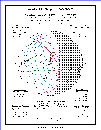|
- - text and links as of last publication - -
February 7th, 2008 Annular Solar Eclipse
The first main astronomical event for this year is an atypical solar eclipse, occurring in the far reaches of Antarctica, South of the Pacific Ocean. It mostly will be observable like a partial eclipse from such inhabited areas like New Zealand, or the easternmost and southeasternmost parts of Australia. Most of Antarctica too will have this partial eclipse. Theoretically, along the eclipse's path, the eclipse is an annular one, that is that the apparent diameter of the Moon is smaller than the one of the Sun, leading to that, at the greatest of the eclipse, a ring of Sun will still be seen, leading to no such spectacular views like the ones providing by a total eclipse and the solar coronal seen, for example. for more about the solar eclipses, theoretically, see our tutorial "Sun Eclipses" The February 7th, 2008 eclipse will be mostly observable from the easternmost and southeastern most parts of Australia, and from New Zealand. The more southeast of New Zealand, the largest the indentation of the Sun. In the southeasternmost part of Australia, the indentation of the Sun will be of about 20 percent, as, in New Zealand, it will reach about 60 percent The Moon's apparent diameter will be of 31' and 10.4", compared to the Sun's 32' and 52.8"
On the theoretical point of view of the eclipses, generally, this one is specific as, instead of travelling West-East, it will, where it's seen like an annular, travel East-West (then heading North), and, further, beginning just at the Earth's terminator, there where the day/night separation will be located. for more about how to observe a solar eclipse, see our tutorial "Observing a Sun Eclipse ". The eclipse's main data are the following (data as of the beginning of November 2007):
. for more about this eclipse and for more about solar and lunar eclipses generally, see Fred Espenak's NASA Eclipse Home Page, NASA/GSFC Observation Reports: the February 7th, 2008 annular solar eclipse was mostly seen like a partial, with the Sun variously indented, function from where the observers were watching the eclipse
Website Manager: G. Guichard, site 'Amateur Astronomy,' http://stars5.netfirms.com. Page Editor: G. Guichard. last edited: 12/28/2010. contact us at ggwebsites@outlook.com |


